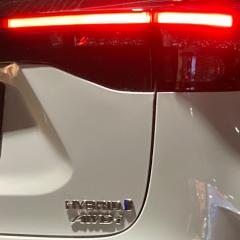Difficulty - Easy but fiddly
Time - About 10 minutes
Tools - None
Frequency - As required. They will probably start to degrade and streak by about 6 months and will certainly benefit from being changed by about 10000 miles or 12 months.
Price and part Nos to be supplied by Lindop Bros Toyota
Thanks to Wollaston for his assistance and the use of his 4.2.
Introduction.
If your car is fitted with the original Toyota wiper blades it makes good economic sense to change only the rubbers instead of the whole blade. The original blades are very well made. They are powder coated rust resistant steel and you will notice how heavy they are. Just look at these steel pins through the joints;

Often, replacement wipers are plastic (even the expensive ones) and after 12 months are starting to wear at these joints. The result is that they will start to flip at each end of the stroke causing a characteristic clunk, clunk during operation. As they continue to wear there is a high risk that the backing spine or pins will contact the glass leaving an arched scratch that will render the windscreen unacceptable for MOT test.
To summarise:- If the wipers are the original steel ones replace only the rubbers with genuine Toyota ones. If they have been replaced with plastic replace the whole wiper blade with genuine Toyota ones and then subsequently just the rubbers. If the genuine wipers have been fitted for more than 3 years check them to make sure the pins are not worn and allow the wipers to flop from side to side.
Don't run the wipers for long periods on a dry screen as this will cause unnecessary wear of the pins and blade. It will also reduce the life of the wiper motor. Always use the correct screen wash as this will reduce degredation of the rubber, resist freezing and not damage the paintwork. Never ever use anti-freeze as this will damage paintwork. A small amount of washing up liquid is acceptable in summer as this will assist in the rmoval of insects but it will also de-wax the car so avoid using it if you are not regularly polishing.
Procedure
To remove the blade, lift the arm and squeeze the plastic clip where the fitting attaches to the wiper arm;

While squeezing the clip push the blade back toward the windscreen and when it clears the end of the arm then thread it under the hooked arm and clear;

CAUTION - THE WIPER ARM IS HEAVILY SPRING LOADED. IT WILL STAY IN THE UP POSITION BUT IF IT FLIRTS BACK IT WILL CRACK THE WINDSCREEN. FOR THIS REASON IT IS WISE TO PUT A FLATTENED CARDBOARD BOX AT THE BOTTOM OF THE WINDSCREEN OR SIMPLY CAREFULLY LOWER THE ARM BACK TO LAY ON THE GLASS.
Now take the blade to a suitable work surface. Look how the new wiper is shaped with a groove right at the top for the tension springs and a groove just underneath for the blade hooks. This what I refer to as the anchor end of the blade with a stopped recess;

To remove the rubber, grip it at the anchor end shown in the above photos and pull quite hard to force it out of the stopped anchor location;

Carefully slide the rubber complete with the stainless steel tension springs out fron all of the arm hooks. Look at the direction it is being withdrawn in relation to the blade fitting above Wollastons thumb;

Now remove the tension springs out of the wiper rubber noting that there is a notch in each one designed to engage a matching lug in the rubber;

Now carefully engage the tension springs into the new rubber making sure that the notches line up with the lugs and that the springs arch up in the middle so the wipers will be concave;

Once the springs are fitted to the rubber you can slide it back one by one through the blade hooks. They are correctly fitted from the bottom of the blade i.e. if you look at the mounting adapter where it hooks onto the wiper arm it is pivoted. Feed the rubber in from the opposite end to the pivot. Make sure the rubber engages every hook of the blade and it will eventually come to the anchor end. At this stage carefully force the rubber just a little bit further until it pops through and locates in the anchor position (as in picture No 4 above).

Now refit the complete assembly back onto the arm. If you haven't done this before it can be quite confusing but remember the other one is still fitted for you to look at! Lift the arm off the glass into the upright position. Position the blade under the arm so that the adapter faces the same direction as the hook as in the third photo above. Now lift the adapter so it is slightly inclined and manoeuvre the blade back and under the hook then up and forward to engage the hook. Pull it fully forward until it clicks. Carefully lower the arm onto the screen.
It will now be streak and noise free.



